Are you ready to learn about some amazing vegetables? More specifically, we will be discussing vegetables that start with the letter C. You may be surprised to find just how many different types of vegetables there are!
So, get out your chopping knife and get ready for a culinary journey of the 46 vegetables that start with C.
1. Cactus
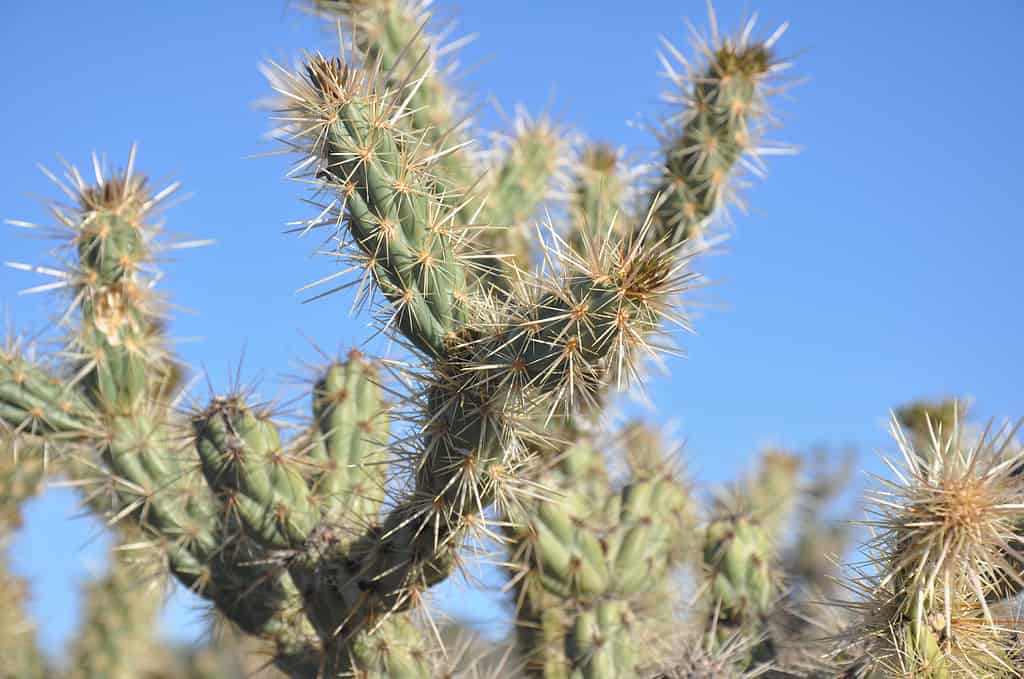
Not all cacti can be eaten, but some varieties are delicious when cooked!
©Jaren Hutchinson/Shutterstock.com
While many wonder if a cactus is a vegetable or a fruit, the truth is, that it’s both! The cactus family, Cactaceae, boasts some unique edible species that can be grown right at home.
In Mexico, the cactus isn’t just a symbol of cultural and historical significance ( a cactus features on Mexico’s flag), but it’s also a culinary favorite. From upscale restaurants to roadside stalls, and certainly in households, cactus finds its place in numerous dishes. In Mexico, a popular cactus that is used in culinary dishes is called “nopales”.
Edible cactus has a unique texture; it’s somewhat crisp yet can turn a tad gooey, similar to okra, when cooked. Flavor-wise, it resembles the mildly tangy taste of green asparagus, beans, or bell peppers.
However, a word of caution: not all cacti are safe to eat. Do your research before eating them, and NEVER eat any random cacti off the side of the road.
2. Cabbage
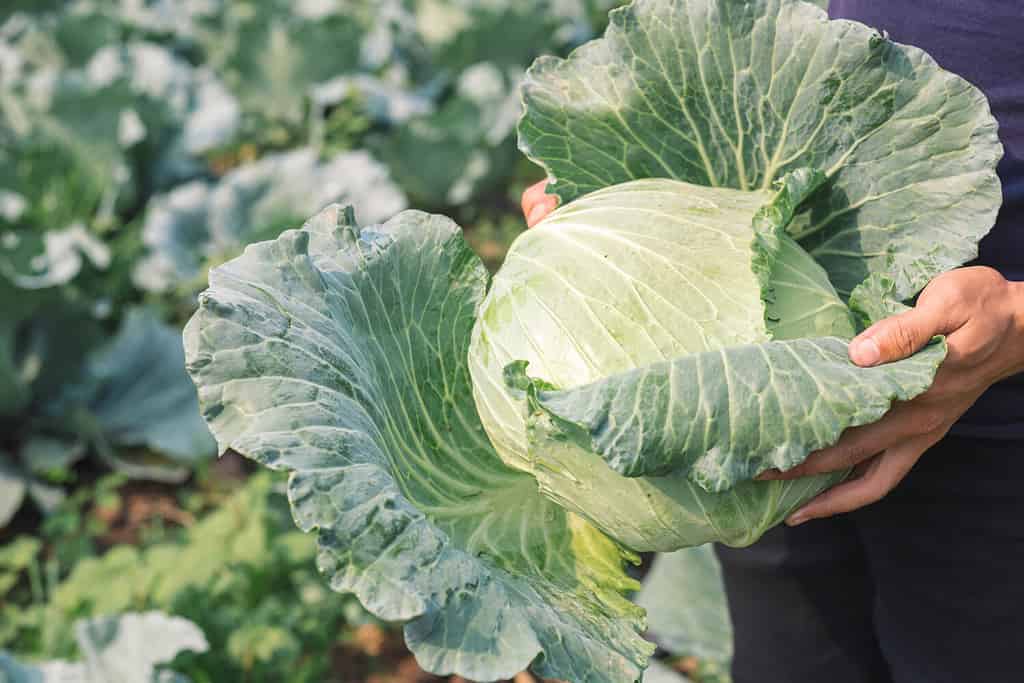
One of the most important vegetables that starts with C is cabbage.
©Parkin Srihawong/Shutterstock.com
Cabbage, part of the cruciferous family, is a leafy vegetable that can be green or purple. Its tight-leaved heads are harvested for consumption and are a significant part of many culinary traditions. For canning purposes, smaller, firm heads are preferred, discarding the rough outer leaves and core.
Cabbage originated in southern and western Europe, but the vegetable has evolved into many different varieties.
When cooked, cabbage readily absorbs the flavors of accompanying ingredients. However, when eaten raw, it possesses a distinct, slightly bitter taste. Though many cabbages have this bitterness, some varieties can be subtly sweet.
3. Carrot
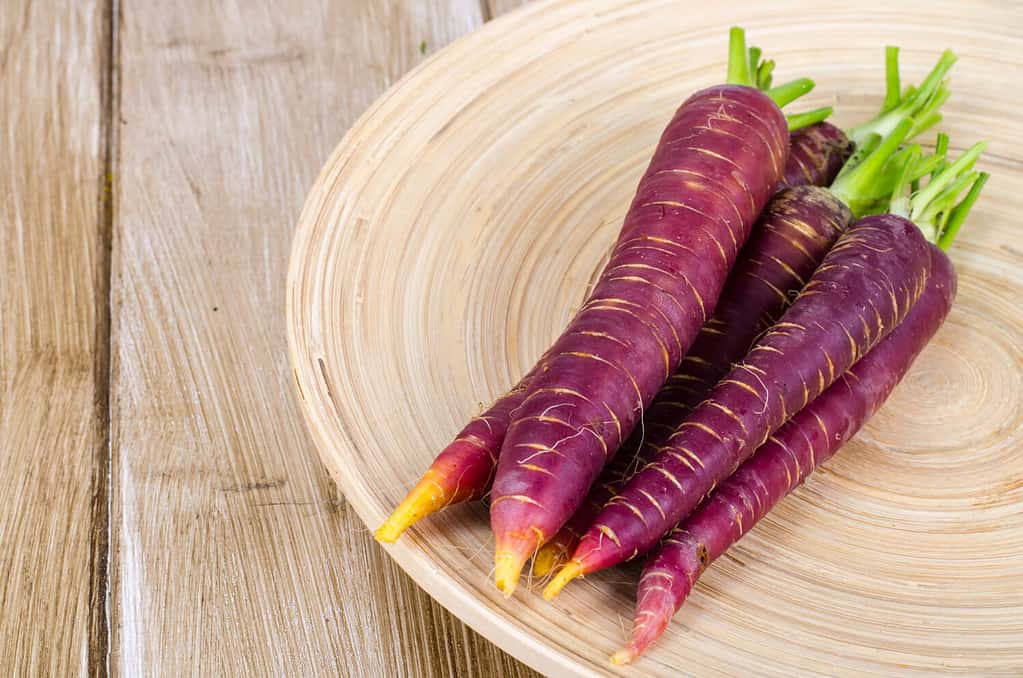
Orange carrots are the most popular, but did you know that carrots come in a whole array of colors?
©ArtCookStudio/Shutterstock.com
Coming in second to potatoes, carrots are among the world’s most loved vegetables, with a staggering 6 million tons harvested yearly. Primarily recognized by their orange color, carrots also come in shades of purple, black, red, white, and yellow. These colorful variants have been cultivated from the wild carrot.
Its origins trace back to Europe, west, and Central Asia, with Afghanistan likely being its primary domestication spot.
Taste-wise, carrots can vary. While their inherent sweetness is due to their sugar content, some might find them having an earthy or even a bitter undertone, influenced by factors like their color and growth region.
4. Cassava

Cassava is a popular root vegetable in South America and other tropical regions.
©iStock.com/tinglee1631
At a glance, cassava or yuca may remind you of potato or sweet potato but with a more robust skin. Thriving in warm, tropical regions, it’s believed to have roots in Brazil before making its way to the rest of South and Central America.
Cassava is also a common root vegetable in Southeast Asia, especially in Indonesia. Meanwhile, countries like Thailand, Cambodia, and Vietnam use it for starch processing and as a source of biofuel.
The taste of cassava root is understated; think of a blend of earthiness with a hint of sweetness and nuttiness, rounded off by a mildly bitter note. Given its subtle flavor, it shines when paired with robust ingredients during cooking.
5. Catsear

Catsear is a vegetable that is commonly found growing in lawns in Europe.
©Wirestock/iStock via Getty Images
Every bit of the catsear plant is fit for consumption, though it’s mostly the leaves and roots that get picked. In certain European regions, catsear leaves find their way into pots as a vegetable or become a part of fresh salads.
Their flavor is fairly neutral, making them a versatile addition to salads or dishes like stir-fries and steamed meals. It’s best to opt for younger leaves since the mature ones can get a bit tough. Unlike the dandelion’s leaves, which can sometimes be bitter, catsear leaves usually maintain a mild profile.
6. Cauliflower
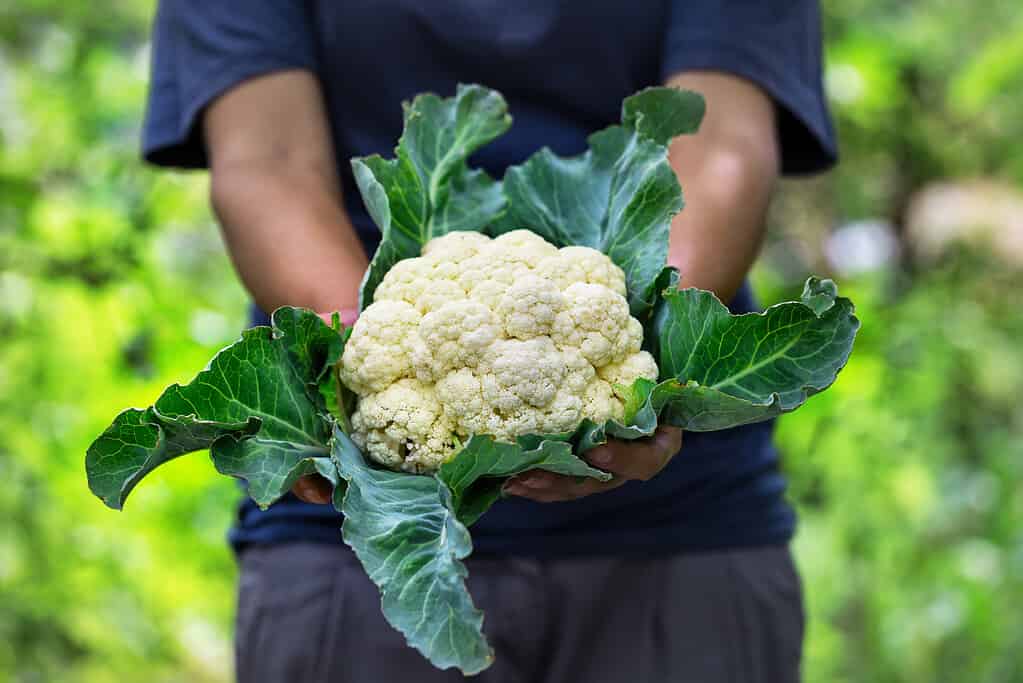
A common vegetable that starts with C that is used across the globe is cauliflower.
©iStock.com/Alexlukin
Cauliflower, a vegetable in the same family as broccoli and cabbage, is generally completely white. However, it’s not uncommon to find it in colors like soft orange, purple, or even vibrant green. While the white variety is a popular choice due to its widespread availability, any colored cauliflower can be used interchangeably in recipes.
Currently, the title of the top cauliflower producer goes to China.
Generations of selective breeding have gifted cauliflower with a taste that leans towards the nutty and subtly sweet side, making it a favorite on many plates. Some might detect a slightly bitter undertone in its flavor profile.
7. Celery

This vegetable has more than 95% water content!
©Kaiskynet Studio/Shutterstock.com
Celery has elongated, juicy stalks that you can eat raw or stewed. Beyond its stalks, its leaves and seeds also find culinary uses.
Comprising mostly water, about 95% in fact, celery has a long history. Ancient findings from Switzerland hint that celery seeds were on the move as early as 4,000 B.C.
Its taste is subtle, carrying a hint of sweetness and a herbal aroma. This unique flavor profile makes it a sought-after ingredient in various savory preparations.
Fun fact: There is a popular myth that because of how few calories there are in celery, you burn more calories than you consume when eating the vegetable. However, this has been proven false. While it is a diet-friendly food, you don’t burn more calories than you consume when eating celery.
8. Chaya
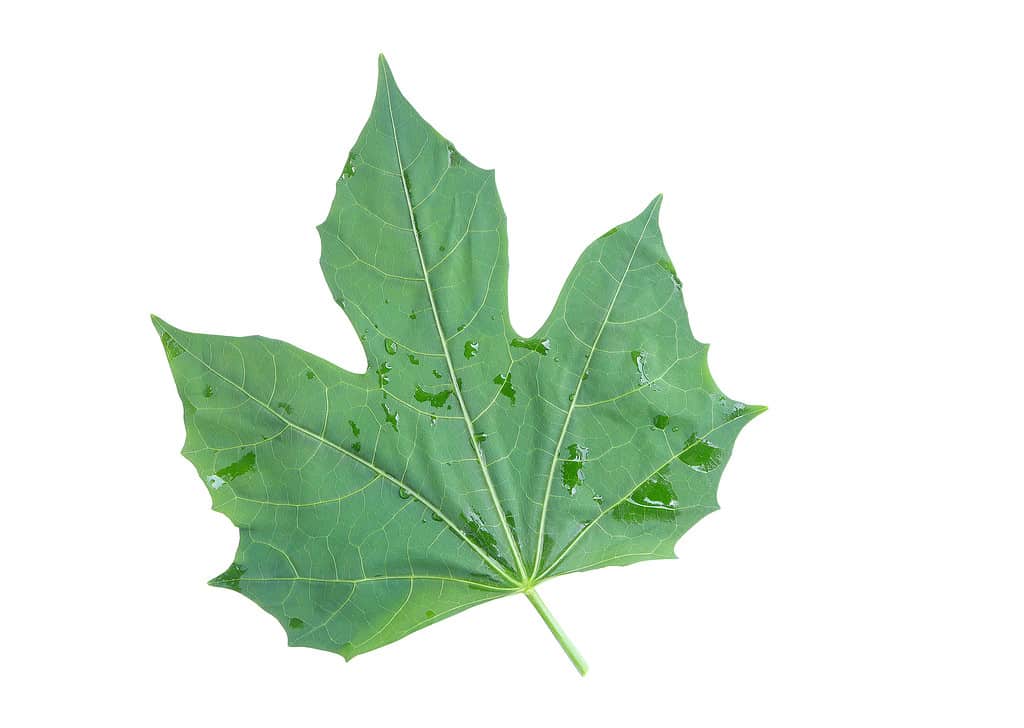
This plant originated in Mexico and is also known as tree spinach.
©yuphayao phankhamkerd/iStock via Getty Images
Chaya is a leafy green that thrives in arid tropical areas. It’s also referred to as tree spinach, kikilchay, chaya col, and chaykeken, with “chaya” deriving from the Mayan word “chay.” The leaves are dark green, smooth with occasional hairs, and shaped somewhat similarly to okra leaves.
Its roots trace back to Mexico‘s Yucatan peninsula, flourishing naturally in forests and thickets.
Touted for its impressive nutritional value, many regard chaya as a superfood. Flavor-wise, it’s reminiscent of spinach, offering a pleasant taste.
9. Cherry Tomatoes

One of the most delicious tomato varieties, perfect for a salad is the cherry tomato.
©aRandomEye/Shutterstock.com
Cherry tomatoes are small, round tomatoes that are thought to be a hybrid mix of wild currant-type tomatoes and the larger, more common garden varieties. They can be as tiny as the tip of a thumb or as big as a golf ball, with shapes varying from perfectly round to slightly elongated.
Their origins are traced back to the regions between Peru and Ecuador.
What sets cherry tomatoes apart is their sweetness, which stands out when compared to many other tomato varieties. They also possess delicate skin and high water content, making them exceptionally juicy.
10. Chickpea

With a high protein content, chickpeas are one of the most nutritious vegetables.
©innakreativ/Shutterstock.com
Chickpeas pack a dual punch, being rich in nutrients and hence categorized as both a vegetable and a protein. While the most common variety sports a beige hue and rounded shape, chickpeas also come in colors like black, green, and red.
Research suggests chickpeas first sprouted in eastern Mediterranean regions like the Levant and ancient Egypt.
Taste-wise, they stand apart from typical legumes, offering a subtle nutty essence with just a hint of earthiness. Given their mild profile, the flavor of chickpeas can be influenced by their cooking method and accompanying ingredients.
11. Chives
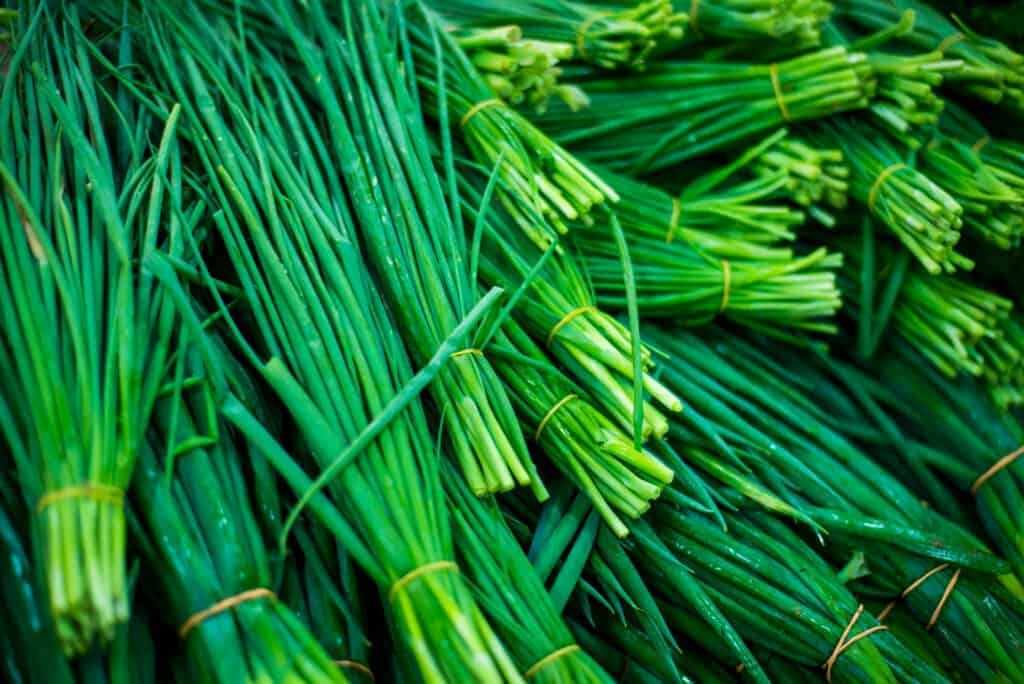
Chives are a relative of onions and garlic, but only their stems are used for culinary purposes.
©Heitor Pergher/Shutterstock.com
Belonging to the Allium family, chives are close cousins of onions and garlic. Unlike their relatives, they don’t boast an edible bulb. Instead, the whole slender length of chives can be consumed. They are more delicate than the robust green onions.
Chives have roots in Europe and Asia, with potential origins in North America, though there’s some debate about whether they are truly native or have naturalized there.
In terms of flavor, chives strike a gentle balance between onions and garlic, predominantly showcasing an oniony taste with a hint of garlic.
12. Collard Greens

A hardy, leafy green vegetable that starts with C and is packed with nutrients is collard greens.
©Fanfo/Shutterstock.com
Collards and kale share a close genetic relationship, but years of cultivation have given them distinct textures and tastes. Collard green leaves boast a sleek, almost shiny surface with clear veining. They are typically large, ranging from light to deep green, and their stems are notably tough.
Their roots trace back to the Eastern Mediterranean. Packed with vitamins and minerals, collard greens are a powerhouse of nutrition, aiding in disease prevention and health promotion.
When consumed raw, collards offer a slightly bitter taste, though not as strong as kale. Cooking them softens the bitterness, revealing a gentle, earthy undertone. While available year-round, collards are at their flavorful peak during the colder months.
13. Common Bean
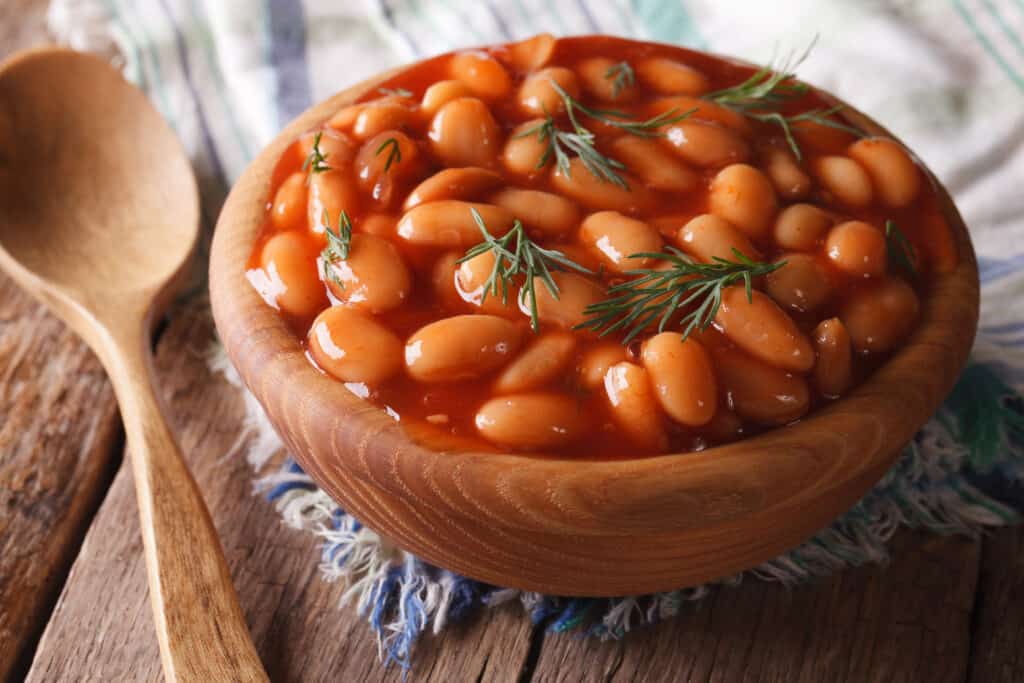
Beans come from the Americas and are extremely rich in nutrients and fiber.
©Sergii Koval/Shutterstock.com
The common bean is an annual plant that grows globally, celebrated for its protein content and nutritious dried seeds. Sometimes, its leaves are eaten as greens, while its leftover stems serve as feed for livestock. Among its many types, you’ll find the likes of kidney, pinto, and haricot beans — with the latter often being a key ingredient in baked bean dishes.
Originally, beans hail from Central and South America, though a handful of its species can also be found in North America.
Each variety of bean offers a unique taste, making them distinct in flavor profiles. You can enjoy these raw, boiled, sautéed, or even pickled.
14. Calabrese Broccoli
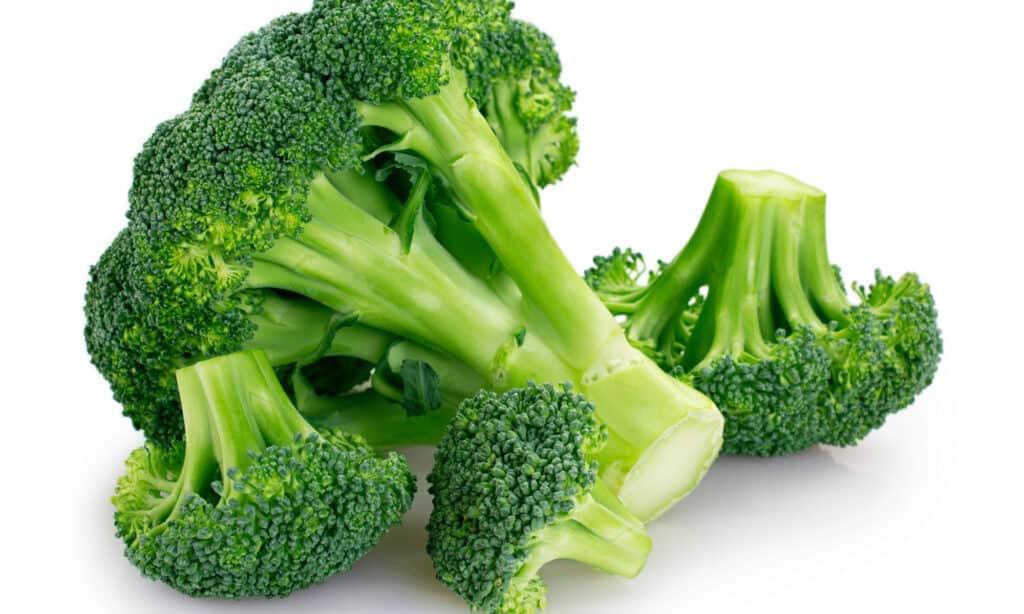
Broccoli Calabrese is one of the most commonly found types of broccoli.
©Valery121283/Shutterstock.com
Taking its name from the Calabria region in Italy, calabrese is a variety of broccoli. In fact, this is the variety of broccoli that most people are familiar with is Calabrese. Though often labeled as broccoli in stores for ease, they’re not exactly the same. When you pick calabrese, you’ll first notice a dominant central head, but once that’s removed, smaller heads begin to grow. You can harvest it from the warm days of summer up to the chilly onset of frost.
While traditional broccoli is a bit tougher and carries a slight bitterness, calabrese stands out with its soft texture and gentle flavor. Rich and savory, it can be enjoyed raw, steamed, or sautéed in a stir-fry.
15. Camas
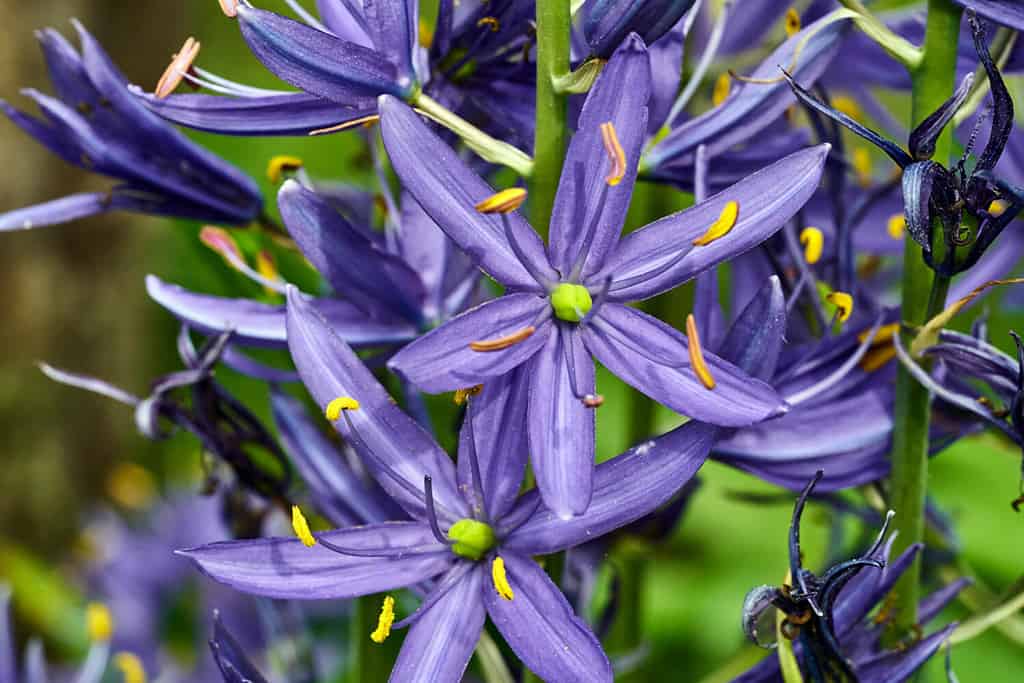
The flowers of the camas plant are beautiful and the root can be eaten.
©Jonas Vegele/Shutterstock.com
Camas, hailing from the lily family, boasts stunning purple flowers with six petals, surrounded by blade-like leaves. Underneath the soil, about four to eight inches down, camas bulbs can be found, bearing a resemblance to tiny, compact potatoes or lily bulbs.
This plant calls the vast regions of southern Canada and the northwestern parts of the U.S. its home.
In terms of taste, when boiled, the bulbs give off a potato-ish essence with a slightly gooier texture and less fluffiness than your typical spud. They’re versatile in the kitchen – you can bake, roast, dry, or even munch on them raw. Interestingly, many indigenous tribes from the Northwest leaned on these bulbs as a primary natural sweetener.
16. Corn

Popcorn is just one of more than 200 different corn varieties!
©iStock.com/rfranca
Many scientists believe that corn originated in Mexico around 9,000 years ago. There are over 200 different varieties of this vegetable that was one of the most important food sources for the Native American tribes in both North and South America.
Corn is packed with calories and nutrition; combine that with the fact that it is easy to grow and affordable, and it is easy to see why it is still one of the most important food crops in the world.
Corn can range from being essentially tasteless to extremely sweet and flavorful. The many different types of this vegetable are used for many different purposes, such as flour, livestock feed, alcohol production, fuel, and, of course, popcorn!
Comprehensive List of Vegetables That Start with C
- Cactus
- Cabbage
- Carrot
- Cassava
- Catsear
- Cauliflower
- Celery
- Chaya
- Chayote Squash
- Cherry Tomatoes
- Chickpea
- Chicory
- Chives
- Collard Greens
- Common Bean
- Caigua
- Calabrese
- Camas
- Candy Roaster Squash
- Capers
- Capsicum
- Cardoons
- Cavolo Nero
- Celeriac
- Celtuce
- Ceylon Spinach
- Cha-om
- Chard
- Chickweed
- Chinese Artichoke
- Chinese Broccoli
- Chinese Eggplant
- Chinese Long Bean
- Chinese Mallow
- Choy Sum
- Chrysanthemum Green
- Cime de Rapa
- Common Purslane
- Corn
- Cos Lettuce
- Courgette
- Crookneck Squash
- Cucumber
- Carola Potato
- Caper
- Caraway
Summary of Vegetables That Start With C
| Vegetable | Benefits |
|---|---|
| Cactus | Vitamins C and K, magnesium, calcium, iron, and potassium |
| Cabbage | Vitamins A, K, and C, folate, fiber, magnesium, and potassium |
| Carrot | Vitamins A and C, calcium, and potassium |
| Cassava | Vitamin C, niacin, riboflavin, and thiamine |
| Catsear | Vitamins K, C, and A, potassium, and calcium |
| Cauliflower | Vitamins C and K, and folate |
| Celery | Vitamins A, K, and C, folate, calcium, and potassium |
| Chaya | Vitamins A, B, and C, iron, protein, iron, calcium, and carotene |
| Cherry Tomato | Vitamins C, E, and A, and potassium |
| Chickpeas | Vitamins E, C, and A, iron, magnesium, folate, and potassium |
| Chives | Vitamins K, C, and A, folate, calcium, and potassium |
| Collard Greens | Vitamins A, C, and K, iron, and magnesium |
| Common Beans | Vitamins A and K, magnesium, and potassium |
| Calabrese | Vitamin C, iron, potassium, and calcium |
| Camas | Vitamins, minerals, calcium, magnesium, and fiber |
Disclaimer: While some items on this list may technically be classified as fruits or herbs from a botanical standpoint, they are commonly prepared, eaten, or regarded as vegetables in culinary contexts. Hence, they have been included in this list for their widespread culinary usage as vegetables.
The photo featured at the top of this post is © Wirestock/iStock via Getty Images
Thank you for reading! Have some feedback for us? Contact the AZ Animals editorial team.







